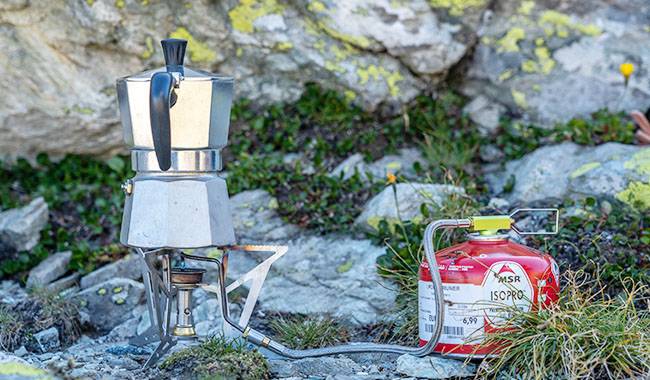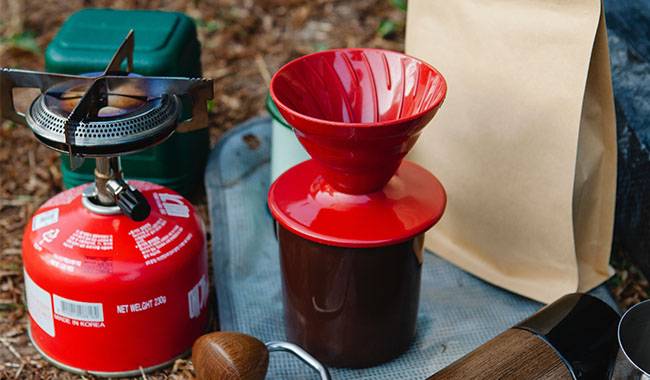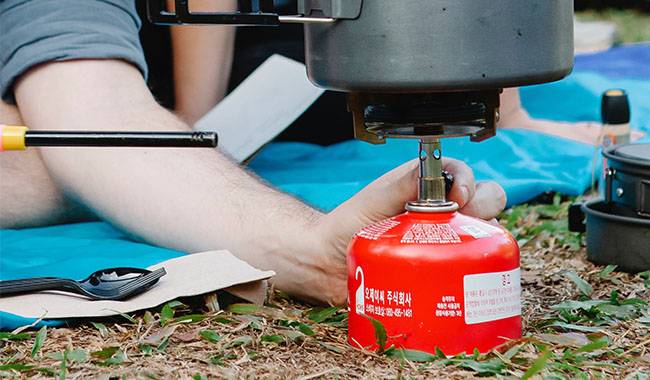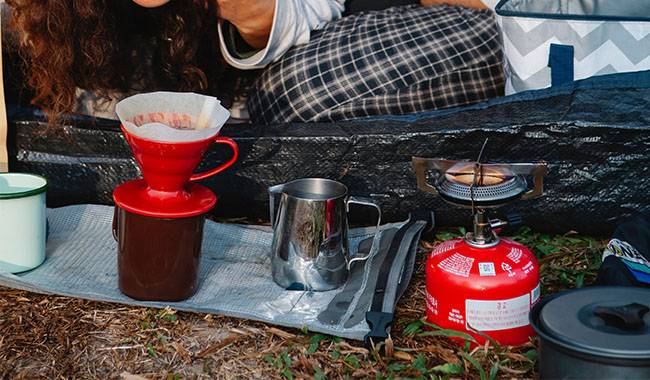
The mountaineering and hiking community is divided into two camps: some people cook only with gas, while others prefer gasoline. This confrontation is no less than the eternal dispute between skiers and snowboarders: each one is ready to defend his preferred fuel with a plethora of arguments. In fact, the choice of options depends on the form and conditions of the trip. For beginner campers who have not yet decided which camp to join, this article LCN Outdoors will explain the advantages of each fuel outdoor and its burners.
How The Burners Work
The touring burners can use gas, gasoline, or both fuels. Based on this, they are divided into three broad categories: gas, liquid fuels, and multi-fuel.
Gas burners
Gas burners vary in capacity and how they are attached to the gas cylinder – this is reflected in their weight and size. Smaller burners are placed or screwed directly onto the cylinder. They are the lightest and most compact, but are only suitable for small groups, preferably two people. Larger pots and pans cannot be placed on such burners, or even if you put them on, the process will be long due to the low power. Medium and large burners can be connected to cylinders via external hoses. Their design and power are suitable for cooking food in large pots.
Independent cooking systems can be identified: bottles and similar. They consist of a gas burner, a draught-proof device, and a kettle with a radiator. These systems are convenient for heating snow, with minimal fuel consumption, but the range of applications is severely limited by the volume of the pot, which usually does not exceed 0.26 gal (1 liter).
Sometimes donkeys do this: they heat to snow and water in a jet boiler, then pour the boiling water into a larger pot and cook it on another burner – all that’s left is to keep it boiling.
Oil and multi-fuel burners
There are two types of gasoline (liquid fuel) burners: dedicated gasoline burners and multi-fuel burners. In the case of dedicated gasoline burners, the fuel tank is usually integral to the burner. This group includes older burners and their more modern modifications, as well as modern gasoline burners.
The older design gasoline primaries will be the heaviest, weighing about 4.4 lb (2 kg). If you are planning a long hike with a large group, this weight, especially considering the amount of fuel for the entire route, doesn’t seem terrible. But for a small group, it’s not the best choice.
Modern gasoline prime movers already use lightweight alloys that weigh on average about 2.2 lb (1 kg). The weight of a multi-fuel burner that can be used for cooking with gasoline, plus a fuel bottle, a minimal maintenance tool, and a case, is about 650-700 grams. Lightweight versions of multi-fuel burners with a titanium body from well-known manufacturers can also be found on the market. Please note that burner specifications on the Internet usually show the weight without the fuel tank and pump.
Many hikers I know still use gasoline-powered Hornets and Dustan’s and are on the most difficult hikes. The new equipment works reliably and helps prepare food quickly for large groups. Indeed, you should know how to use it. Regular dedicated burners are inexpensive and you can replace them every few seasons without having to wait for the separate units to wear out.
Multi-fuel burners are usually made from liquid fuel burners by adding an adapter for a threaded gas cylinder and a nozzle for the gas. The tank and pump are connected to the burner via a hose, so it is easy to turn it into a gas burner and vice versa – if the design provides an adapter, only the adapter and nozzle need to be replaced.
How to Choose Fuel Outdoor

Type of gas cylinder
Gas cylinders for burners come in all shapes and sizes, and not every cylinder fits every burner. The most common are threaded connections. They feature reliable connections and are available in a wide range of gas mixtures and manufacturers.
The second most popular type is the clevis-connected cylinder, commonly referred to as “Trichlor” because of its shape. They are cheaper but can leak if not connected to the burner hose. They can only be attached to a threaded burner by an adapter. Collet burners are mainly used for burners with hoses – threaded burners that are not structurally stable and cannot hold pots (although you can boil cups of water).
In Europe, piercing bottles are popular. They have the advantage of low cost, but the disadvantage is that the burner cannot be removed until the gas is used up, otherwise the contents of the cylinder will leak. And the burners used for them are only suitable for special burners, not for threaded cylinders.
Gasoline quality requirements
The main advantage of gasoline igniters designed for older gasoline cylinders is that they work well on almost all fuels. Multi-fuel burners, despite the name, are very picky about the quality of the gasoline. The cleaner the gasoline, the less soot there is to clog the burner. The most expensive gasoline at the pump does not mean the highest quality. Often, various additives are used to raise the octane number and “pollute” the gasoline. However, the burner can use any fuel, but if a high-quality fuel is used, it must be cleaned less often.
The ideal choice for a liquid fuel burner is gasoline. In Europe and America, it is sold in every other outdoor building or hardware store under the guise of a solvent.
Multi-fuel burners can also use other liquid fuels, such as paraffin and diesel. In the old days, we used to take aviation paraffin to camp with us. But it was harder to get, but closes were sold everywhere and were cleaner too. After diesel, you have to clean the burners more often. Therefore, this fuel should only be used in desperate situations.
At many gas stations, gasoline is diluted with water. In sub-zero temperatures, it freezes and clogs the burners. If you pour gasoline from the plant into regular plastic bottles, make sure they are cleaned and well dried.
Fuel availability and price
In Central Asian countries, natural gas may be difficult to obtain or its price is good value for money. Gas is not allowed on planes and maybe a problem on trains – gas cans are usually not allowed in train stations. Gasoline is available everywhere.
On a ski trip in Svalbard, we ran out of gas a few days before the end of the route. Fortunately, there was a snowmobile passing by. We asked for some fuel to be drained from the tank and continued our hike in comfort.
Fuel consumption during the trip
When cooking for a group of 4-5 people, a high and medium power gas stove uses roughly the same amount of fuel as a gasoline stove – 40-50 grams per person per day. This is in the absence of a snowball fire with hot drinks and food that needs to be cooked for three meals a day (i.e., not sublimates or doilies). With snowmelt, consumption will increase to 60-70 grams. If a significant portion of the route is conducted in sub-zero temperatures or at high altitudes, then consumption may increase to 80-100 grams per person per day.
In a small group (up to 4 people), gas consumption can be significantly reduced by cooking with an integrated system or low-power burners. And if you eliminate hot lunches and use sublimated foods or ready-to-eat cereals, you can reduce consumption to 15-20 grams.
The weight of fuel on the route depends not only on its consumption and the number of days. For example, the weight of a standard 450-gram gas cylinder is 670 grams. It turns out that for gas, one-third of the total weight is tare weight. An empty gas cylinder cannot be disposed of without harming nature, so you have to take it to the nearest garbage can.
Gasoline is transported in ordinary plastic bottles – the weight of the container is so small that it can be disregarded. And gasoline has a lower density than water, so a liter of gasoline weighs 750-800 grams, depending on its type.
We refill gasoline into regular food-grade plastic containers (soda bottles, etc.). This avoids unnecessary questions from law enforcement agencies (technical bottles are not shaped like food bottles and can be seen immediately) and prevents gasoline from leaking (factory bottles often have caps that are not turned in completely and also lack an internal protective plastic rim to prevent the liquid from leaking).
What Is The Difference Between The Burners?

Which burner is more convenient: gas, gasoline, or multi-fuel? There is no single answer, it all depends on the situation. Let’s compare the different types of burners according to the most important criteria
Ease of use
Gas burners are very easy to use. Just screw on the cylinder, turn on the tap, light it and you’re ready to cook. Even novice hikers can easily do this job.
Gasoline and multi-fuel burners are more complicated to operate. The process looks like this.
- Pour gasoline into a special container (in a multi-fuel burner, screw on the pump and connect the hose to the container).
- Pressurize the tank with a pump.
- Preheat the burner (e.g. pour some fuel on top of the flame thrower and burner cup, or open the fuel tap briefly).
- When the heating fuel is used up and the burner is hot, you can start cooking.
This process is actually not as complicated as it seems, but it does take practice.
On some camping trips, we used to use a gas-heated multi-fuel burner. You put a gas can on the burner, wait half a minute for it to get hot, and then switch the gas to a can of gasoline. A 230-gram gas bottle is enough for 30-40 days of camping. This avoids unnecessary burning of the burner, which can happen when heating with gasoline.
Construction and reliability
The gas burner is very simple and there is hardly anything to break. Only the hose connecting the burner to the cylinder is fragile. Although it is protected by a metal braid, it can be burned or punctured inadvertently. Some gas burners have plastic elements that can easily be broken in cold conditions or if you don’t have enough strength.
Most gas burners are not detachable. On the one hand, this adds strength to the structure because there is nothing to break. On the other hand, if the burner gets clogged with poor quality gas (which can happen), you won’t be able to clear it during camping and the gas will simply stop flowing. In an urban environment, you can try heating the burner or blowing it out with high pressure.
There is another element in the construction of gasoline and multi-fuel burners: the gasoline pump. Like any other component, over time it may fail or require replacement of wearing parts. For example, there is a leather or synthetic gasket inside the pump that should be lubricated with a special grease gel once a season and replaced with a new one every 3-4 seasons.
Multi-fuel burner designs that place the cable inside a metal preheat tube are not a good idea. When using regular gasoline from the gas station, this unit often gets clogged and the cable sticks to the tube. Modern burners like petroleum-based fuels do not have such cables.
If you plan to cook with a multi-fuel burner while camping, sooner or later you will have to take it apart and clean it. How often you do it depends on the gasoline. If the gasoline is of good quality, a preventive cleaning before you leave is sufficient.
For large independent expeditions (a month or more) we usually take 2-3 burners of one manufacturer per group. In the event of a serious breakdown, 1-2 working burners can be assembled from them.
Hiking is more likely to repair what
Gasoline and multi-fuel burners are easy to repair. The burner is always provided with a wrench that can be used to unscrew all the screw connections and take the burner apart. Each part can be cleaned, repaired, or replaced. The wrench also includes a fine needle thread for cleaning the nozzle – it is either part of the tool or attached to a separate plastic handle. the needle of the LCN burner is directly inside the body of the burner – just shake it and the nozzle is ready for cleaning. Manual cleaning is only necessary in the case of very serious blockages.
In order to repair a damaged burner hose, it can be routed with metal clamps of the right diameter and metal connector sockets or any other suitable size of the hollow tube. Damaged parts of the hose can be removed by cutting them off and whole pieces of the hose can be connected directly using connectors and clamps.
Until recently, spare parts for multi-fuel burners were only sold in sets. In order to replace a small gasket in the pump, you had to buy an expensive repair kit with many unnecessary parts. Now at Sport-Marathon, you can buy only the parts you need for repairs – it’s convenient.
It is important to bring spare parts and consumables for the burner pump – holster and grease – in the repair kit. There is no need to have a spare flamethrower, as the flamethrower on modern burners is held in place with wire or springs. Usually, 2 or 3 nozzles of different diameters for different types of fuel are delivered together with the multi-fuel burner. There is no need to carry them on the road, just install the required ones at home. Thus, large-diameter gasoline nozzles can also be used for gas, only the consumption will be higher. Gas nozzles for gasoline cannot be used.
If you need to clean the nozzle while camping and do not have a special needle, you can use a piece of the first guitar string or an unraveled cable, such as on a bicycle or bookmark, and you will be fine. Standard sewing needles, even if they are small in diameter, are not suitable for cleaning.
It may be noted that brand-name burners from western manufacturers are more expensive than Chinese burners, but if a critical failure occurs, such as a broken burner part in a severe frost, the manufacturing company is prepared to replace the broken unit with a new burner. And generally speaking, all assemblies are more reliable.
What Fuel is Needed for Winter Hiking

Travel gas cylinders use butane (or isobutane). It is mixed with propane to allow it to burn properly at low temperatures. The winter blend contains up to 30% propane, which allows it to operate properly in temperatures as low as 5 °F (-15°C). Some manufacturers label their gas cylinders “down to 9.4 °F (-23°C)” but actually operate at much higher temperatures, even with expensive and good quality gases. Poor quality gas is unpredictable even in a light frost.
In order to cook properly with gas in winter, you have to artificially heat the cylinder: put it in a sleeping bag overnight, warm it under your clothes, hide it under a windshield closer to the flame, shake it and turn it over, put it on a warming-pan (if the length of the burner hose allows it), etc.
An effective way to cook with gas in sub-zero temperatures: heat some water, pour it into a flat bowl, and put a cylinder in it. It won’t save you from a severe frost, but it will make life easier in moderate subzero temperatures.
Gasoline burners work in freezing temperatures without any problems: filled, pressurized, preheated, and working properly. However, there is another disadvantage. These burners emit more carbon monoxide than gas burners, so you can only cook with gasoline in a well-ventilated Temple. You can also burn gas neatly inside your tent as long as you open the ventilation windows.
In cold weather, it is best to use a small fuel tank (600 ml) for a multi-fuel burner. If there is not enough fuel in the large tank 2.2 lb (1000 ml), there will not be enough pressure to supply it properly and the burner must be primed. If it is not perfectly level, the inlet pipe cannot reach the bottom, and gasoline cannot flow out. In a small tank, there is no such problem because the tube is actually at the bottom.
Tip: Make sure your tent is ventilated, regardless of the type of fuel. Otherwise, you may suffer from carbon monoxide poisoning. This is especially dangerous in wet weather, as the tent can get wet and not breathe well. Unfortunately, there have been several fatal poisonings in the mountains.